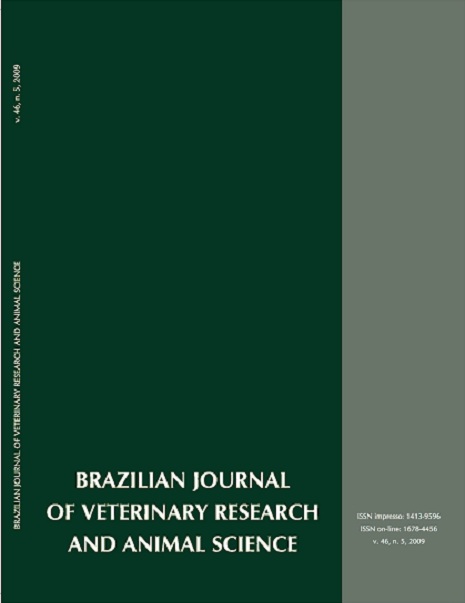Longitudinal study of bone mineral density in healthy, carrier, and affected dogs by Golden Retriever Muscular Dystrophy
DOI:
https://doi.org/10.11606/issn.1678-4456.bjvras.2009.26783Keywords:
Bone densitometry, Radiology, Dogs, Golden Retriever dogs, Muscular dystrophyAbstract
The Golden Retriever Muscular Dystrophy (GRMD) is considered the most appropriate model of the Duchenne Muscular Dystrophy (DMD) in humans. Decrease in Bone Mineral Density (DMO) has been recognized in ambulatory and non-ambulatory boys with DMD. The Radiographic Optical Densitometry is a method to measure the bone mineral content. It was performed radiographing the proximal right tibia next to an aluminum stepwedge. Fifteen Golden Retriever dogs had been used, divided in three groups: Five healthy, five carriers and five affected by GRMD, monthly radiographed, from 3 to 9 months-old. These radiographies were analyzed by image processing software (ImageLab, Softium®). The proximal epiphysis had higher bone mineral density, followed for the metaphysic and diaphysis, respectively. All regions followed has influence the body weight. There was an increase of the bone mineral density in all regions of the three groups. The proximal metaphysis was thought to be the better region to evaluate the bone mineral density because had less correlation and influence of the body weight, and, also, had different significant values to differentiate the groups earlier than the other regions. The potential diagnostic of this densitometric method in GRMD was considered low, however it demonstrated to have great potential in the clinical recheck of this patients due to the high sensitivity for detection of changes in the bone mineral density.Downloads
Download data is not yet available.
Downloads
Published
2009-10-01
Issue
Section
UNDEFINIED
License
The journal content is authorized under the Creative Commons BY-NC-SA license (summary of the license: https://
How to Cite
1.
Giglio RF, Ferrigno CRA, Sterman F de A, Pinto ACB de CF, Balieiro JC de C, Ambrosio CE, et al. Longitudinal study of bone mineral density in healthy, carrier, and affected dogs by Golden Retriever Muscular Dystrophy. Braz. J. Vet. Res. Anim. Sci. [Internet]. 2009 Oct. 1 [cited 2025 Dec. 29];46(5):347-54. Available from: https://revistas.usp.br/bjvras/article/view/26783





